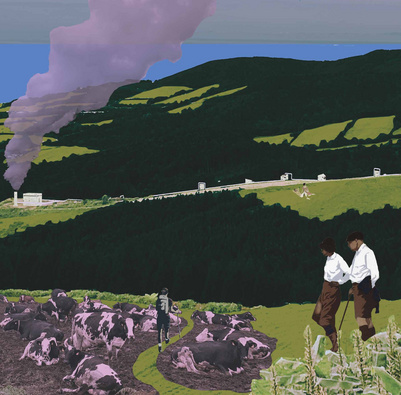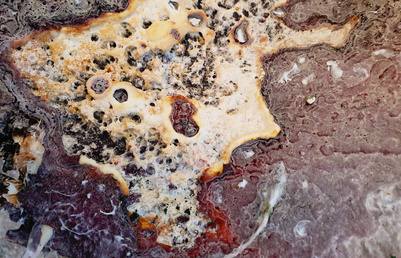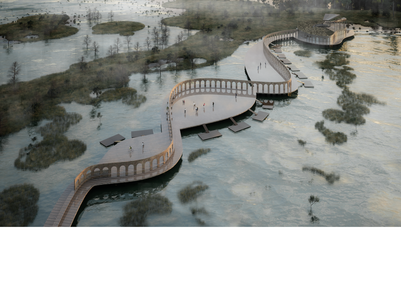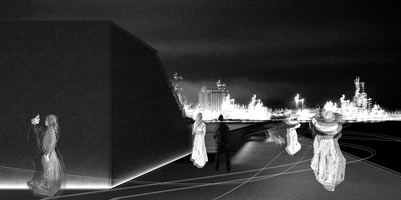My research indicates where there is a lack of solidarity, the Taliban thrives. I argue community building as a social glue promotes solidarity and solidarity will in turn lead to a non-partisan society. The design is concerned with community-building processes, to create a place of exchange and conversation among the different classes and ethnicities of Afghan Society. An arena for the national game of Afghanistan combined with a sports zone, school, and Bazaar constitutes the functions through which the community comes together both in the local and national scales.

From monarchy to a republic, from right to left on the political spectrum and from democracy to religious dictatorship, the nation has experienced a volatile period in the past 100 years.
Coupled with the invasions of the USSR in the 80s and the US for the past two decades, the economy and politics of Afghanistan have become devastated and extremely dependent on foreign powers. This dependency on politics and ideology is echoing in the doctrine of Taliban as they have adapted the Extremist Deobandi ideology from Pakistan through the efforts of ISI(Pakistani Secret Service) and the indirect funding by the US in line with their war against communism. back in the 90s, the newly established Taliban gathered funds as an agent of resistance against the communist invasion of Afghanistan and in the following decade, Deobandi religious Madaris of Pakistan found their way into Afghanistan imbedded in a trojan horse of returning refugees who went back to their country.
Through my research, I realized the repeating pattern between the power structures of Afghanistan and the social mainstream of the country. Where madrasa plays an important role in establishing and reinforcing the group that is entitled to the social contract and monopoly over violence. These two elements are also an integral part of Buzkashi.

In this project, I Focus on Afghans and their predicament through Buzkashi, the national game of Afghanistan. Put in simple terms, Buzkashi is a game of polo without the sticks and a dead goat instead of a ball. It is a game of power and chaos where men on horseback compete against each other to score points.
The chaos in Buzkashi reflects and resembles the socio-political climate of Afghanistan as a nation-state. Afghanistan is made up of an amalgamation of ethnicities and religious sects. Spread over the Hindukush mountain range, Afghanistan connects the political ideas from the plains of Iran to Chinese doctrine and is the meeting point of the Pashtuns of Pakistan and the Turkic tribes of the north.
In Buzkashi, the only thing that actually matters is by whose hand, the goat enters the circle. The game, how long it will be, or how many rounds will be played depends on how much the host is willing to invest in the prize. Through mapping multiple games and the movement of the players, I realized, Both players and spectators are in danger as the players will occasionally charge into the crowd while fighting each other over the goat. Similar to wars in Afghanistan, there are no limits or boundaries and the only thing that matters is by whose hand, the goat enters the circle.
I found cases where buzkashi had had a direct effect on people to the extent in which they were not the same person after witnessing the game. My cases include Taliban commanders, US military personnel, and politicians. So, this powerful effect became the core of the design. The most important case of these life-changing experiences for me is the case of Dr. Whitney Azoy. According to his book "Buzkashi, game and power in Afghanistan", “Leaders are men who can seize control by means foul and fair and then fight off their rivals. The buzkashi rider does the same.” Buzkashi is, therefore, a metaphor for power, rank, and hierarchy, with a huge potential for prestige or shame to the man who stages the match.

The pattern of life-changing effects occurred after the Taliban takeover of Kabul where Taliban soldiers who had never experienced city life started spending time in the city after the takeover was completed, and That was it! I was determined to design a system that would bring Buzkashi to everyone in Afghanistan. Wherein different cultures and political views and religious sects would meet. Where under the disguise of fun and sportsmanship dialogue would happen.
To create this system, the failed invasion plans of the world superpowers came to my aid. You see, both USSR and the US adopted this road plan called the ring road and according to this plan, you would be able to control the entirety of Afghanistan by simply connecting the five most populated cities by road. As George Bush claimed in his speech in 2007: Where the roads end in Afghanistan, the Taliban begins… in other words roads promote enterprise, enterprise provides hope, hope is what defeats this ideology of darkness.
Well, what George Bush and Brezhnev got wrong was that this ideology of darkness would not be destroyed by economic ease or faster transportation of their troops but through dialogue among Afghans where they can reach consensus. So, basically, I implement the same ring road but with Buzkashi instead of roads, and community building instead of focusing on enterprises.
Out of the five culture hubs of Afghanistan, in which four of them already have facilities for games of Buzkashi. According to my analysis of each city, A Buzkashi arena is usually coupled with other public functions such as other sports pitches and/or hotels or wedding halls and is located on one of the main axises close to social nodes such as schools and recreational places or in this case the main police headquarters of the city.
Based on this information I located the arena site for Kabul, the only city out of five that did not have its own Buzkashi arena. I landed in the heart of the city where people from all classes use it. with the following landmarks: Id Gah Mosque, Ghazi Stadium, Afghanistan Football Federation, Omar Private Museum, Kabul Chamber of Commerce, Tape Marjan Graveyard that houses Nadir Shah’s tomb king of Afghanistan 1929-1933, Afghanistan Cricket Federation, Ministry of Defence, De Hahiu Mosque, Independence Minaret Square, Old Fort of Kabul.
Also, the site is located next to the intersection between one of the main city arteries and the most commercial street of the capital. The design site is named Chaman Hozoori which translates to “participatory greenery”. The field is walled with brick columns and remains of what used to be a metal fence that has been stolen. Due to lack of maintenance, The surface of the ground is rough and the grass has died out.
Street sellers can be found all around the walls of the site who literally sell anything and everything. As there is a saying in Persian: From the milk of a chicken to the life of a human. Since the Taliban takeover brought with it an even harsher economic situation, the number of sellers has increased exponentially, and sometimes they even open shops inside the field itself.
The architectural design incorporates the surrounding site walls as well as playing with the level differences between the inside and outside of the walls. As you can see in these diagrams. The placement of the functions on-site abides by the principles of Islamic urbanism. Here we see the historic city center of Aleppo and as highlighted in the image, you have a nucleus containing power structures, education, and religion. These functions have been glued to each other by streets of bazaars that shape the economic heart of the city. The same principle is applied to the site where the different activities are glued into the conscience of the community via the everyday use of the bazaar.
In a rural game of Buzkashi, the game is not defined by strict dimensions or borders but rather continues as long as the horse can and is only blocked by say a cliff, river, or a house wall. The same principle shapes the Buzkashi arena on-site as the field is defined by the functions that surround it. Bordering madrasa on one side and the sports zone and bazaar on the other sides, the field is like a peninsula where the game both physically and ideologically contaminates its bordering functions.
This contamination happens by bringing multiple dichotomies together.
Women Vs. Taliban
The Taliban will learn to tolerate women and accept them as a part of society as they will be a part of the game under the Islamic laws.
Talib and Buzkashi fan
Where a Pashtun Talib meets a none Pashtun community and the discussions that will follow.
Madrasa and Buzkashi Arena
The physical and philosophical rigidity of Madrasa meets the flexibility of Buzkashi through the Buzkashi experience of a student from the Madrasa window
Student and Chapandaz
When a controlled life of a student is contaminated by the freedom of a rider
Hegemony and Politics Vs. Authoritarianism
Politics means to be among others. it requires communication.
A madrasa for girls and another for boys shapes the right side edge of the buzkashi arena. Just the simple fact that education is for both girls and boys is the first trojan horse of the site which among other trojan horses shapes the design. In terms of ambiguity, contamination, collaboration, dialogue making, and symbolism the different trojan horses hide within the possibility of reform.
To the north of the arena is the second and third architectural trojan horses. Through the modification of the Mashrabia concept in Islamic house design, five spaces are created for women to be spectators of the game without being seen. HAHA a Sharia law loophole. An architectural veil to add being a Buzkashi fan as Afghan women’s right.
The backside of these veiled podiums is extended indoor spaces for indoor sports activities where afghan girls and women can gather and create a stronghold of their rights on site. On the edge of the sports zone, three lines of collonades extrude the facade to create two open-air pockets for outdoor sports that can host activities outside. Through the installment of curtains, these spaces can become another loophole in the sharia law of Taliban HAHA.
The same as the Aleppo city plan, the bazaar function on the end of the commercial street axis gives indirect legitimacy to the illegal street sellers around the site. A psychological glue to stick the site and its trojan horses onto the minds of people who shop there. In order to design the bazaar for the everyday use of the streetsellers, I used the principles of A-functional architecture by Stephan Gage. The following principles make the spaces of the site A-functional: Variety of spaces, abstract interpretability and abstract guidance, and discourse responsivity.

After having studied Hassan Fathy’s work I have adapted the Vault and arch-making method of inhabitants of the Nubian desert for the construction of the building. In this method, there is no need for highly trained workers or professional architects to construct buildings. All construction materials are locally sourced and the site will be built by the community who will use the space. brickwork will be done by men who will be learning a simple method of construction and will have jobs for the duration of construction. In order to also include women in the process, the fabric needed for the different aspects of the design will be produced by them as HAHA another loophole in the strict laws of Taliban.
As a finishing touch for the design, saffron, cotton, and hemp vegetations will be scattered around the site as the last trojan horse. These vegetation have been chosen after careful analysis of the Afghan climate and economic investment and profit. This hopefully will result in two middle-aged men having a conversation about them and one of them deciding to purchase seeds.
The site follows a five-stage growth model. At the end of each phase, the design is complete as it is but can grow to become more comprehensive with each proceeding stage.
This project aims at community building and discussion in the neighborhood, city, and nation as a whole through a bottom-to-top strategy. Stemming from everyday life and reaching to the top to change what Taliban thinks Taliban is.



























































